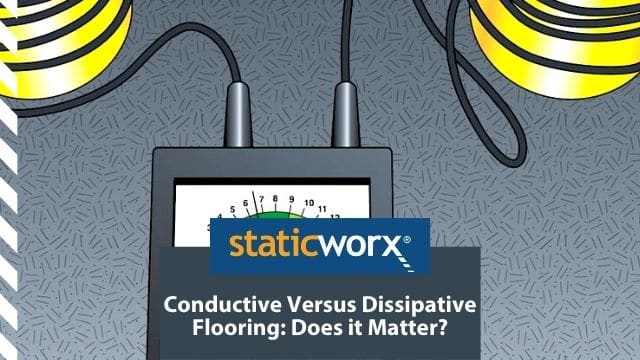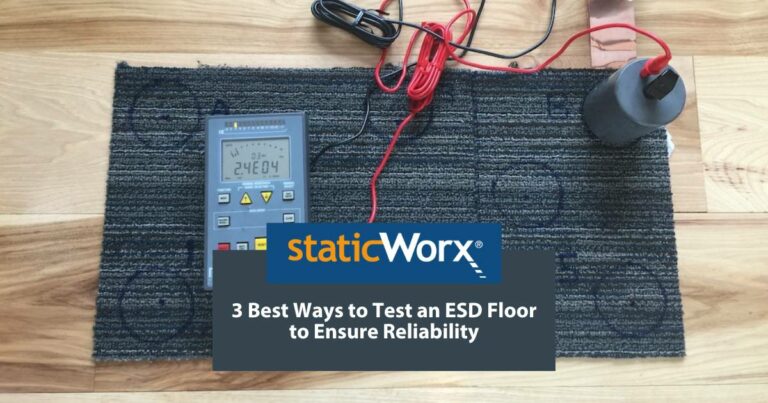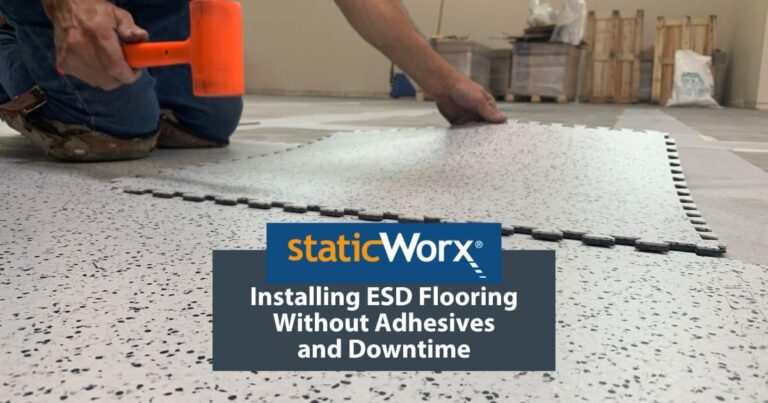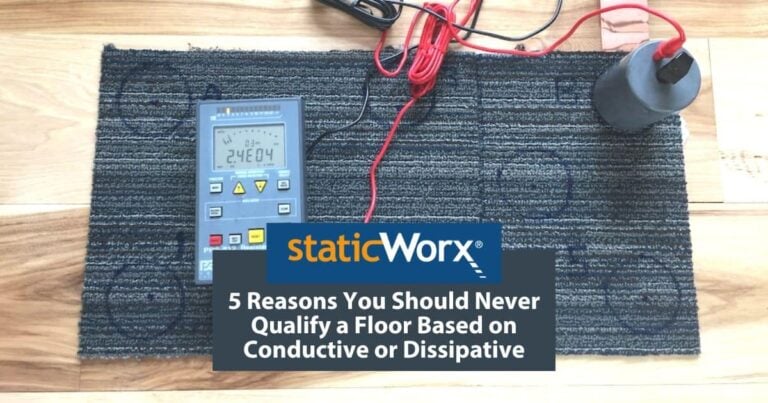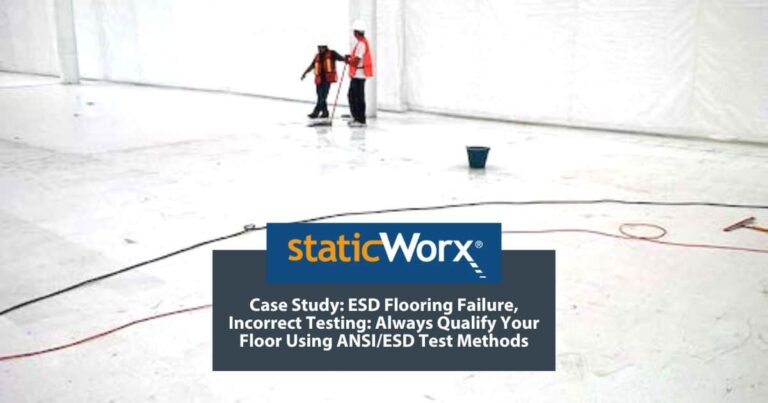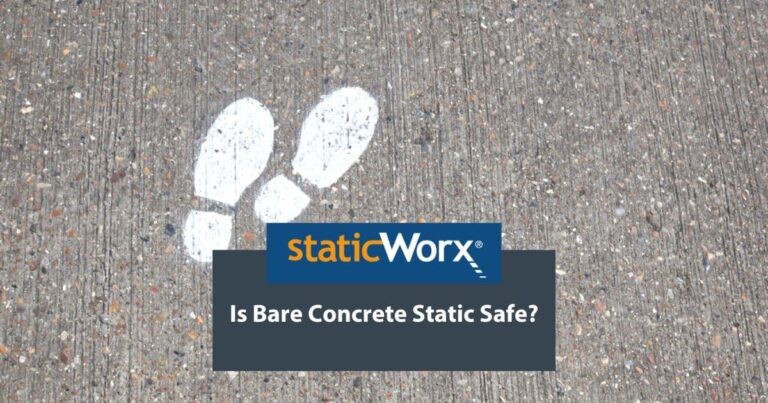Learn the differences between ESD solid vinyl tile and interlocking ESD tile. The post compares specs, installation, maintenance and intangibles.

Conductive and Static-Dissipative Flooring: What's the Difference?
The Layperson's Answer
13 min read, 5 min videos
Should I choose a conductive or static-dissipative floor?
This is one of the most common questions we hear from buyers and specifiers. Most of the time, when people ask – or assume, incorrectly, that they should use one or the other – it’s because they don’t really understand the difference. Technically, conductive and static-dissipative are descriptive terms, defined by the electrical resistance of the floor, as measured by an ohm meter, according to ANSI/ESD Standard Test Method 7.1.
Conductive floors measure below 1.0 x 10E6 ohms to ground.
Static-dissipative floors measure above 1.0 x 10E6 and below 1.0 x 10E9 ohms to ground.
Floors measuring above 10E9 are insulative (with little to no measurable conductivity)
Okay, you’re thinking. That’s all well and good – in practical terms, what does this mean?
Pretend for a moment that you’re emptying water from a large jug to a smaller container. To control the flow of water, you grab a funnel. As you pour, water collects in the cone then moves through a hose that’s narrower than the cone. The narrow hose slows the rate at which water leaves the cone and flows into the container.
Enlarging or shrinking the diameter of the hose will either increase or restrict the rate at which water is “discharged” from the funnel.
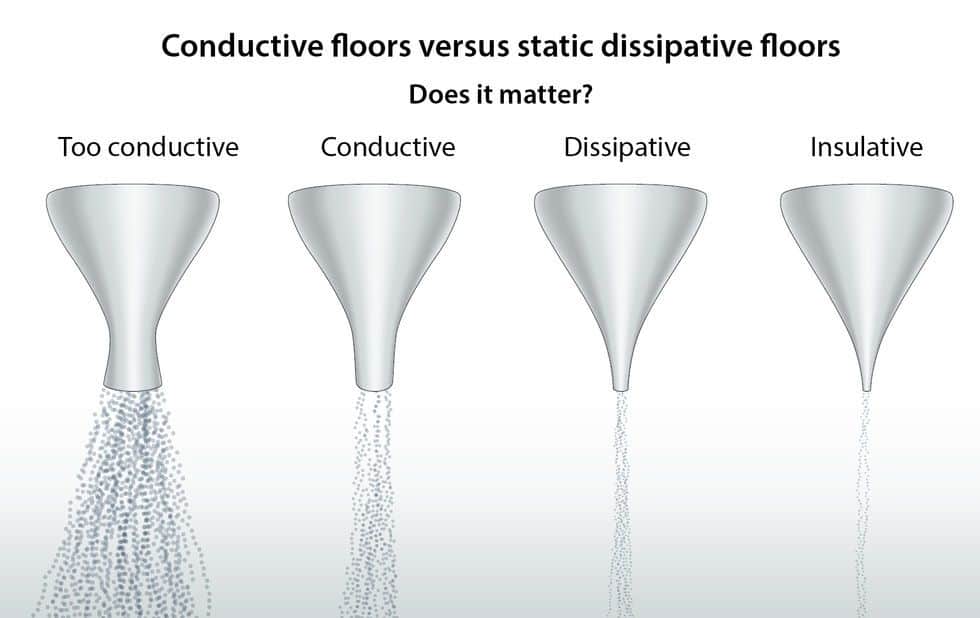

The rate at which static charges flow is determined by the degree of conductivity or static dissipation.
Like a funnel with a large open hose, the conductive elements in a conductive ESD floor allow static electricity (or any form of electricity) to flow quickly across its surface or through the thickness of the flooring material.
Static-dissipative flooring, on the other hand, is more like a funnel with a narrow hose. With less conductivity, static flows across and through the thickness of the flooring material at an appreciably slower rate.
How ESD Flooring Works
The conductive elements in a properly performing ESD floor draw static away from a charged person or object, and through the thickness of the flooring material. From the floor tiles, static charges move to and across the underlying ground plane – conductive adhesive or underlayment – to copper strips placed at the perimeter of the room. From the copper strips, charges move to an A/C outlet or other type of ground connection to ground.
The graphic below shows the flow of static electricity from a person on an ESD floor to ground.
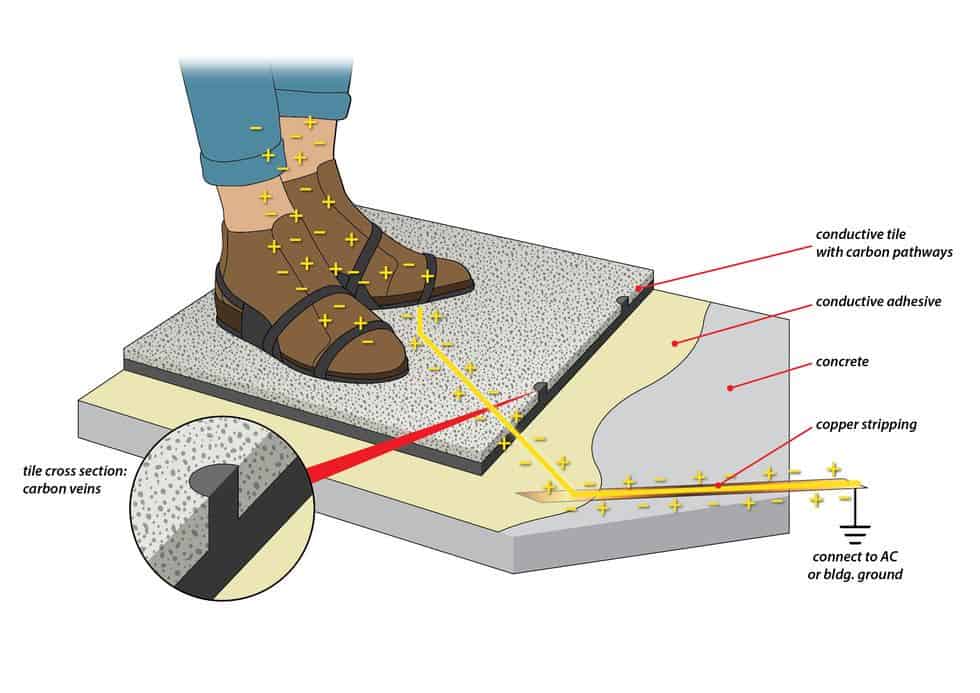

Conductive Floors
A conductive floor is more conductive – or less resistant – to the flow of electricity. A highly conductive floor – measuring 2.5 x 10E4 ohms to ground or below, for example – provides too little resistance. Like water gushing through a funnel with an overly large hose, static charges will race across or through an overly conductive floor.
Electronics Environments

In electronics manufacturing and handling environments that follow protocols set out in ANSI/ESD S20.20, everyone in or walking through the space is required to wear special ESD footwear. As part of its design, ESD footwear has built-in electrical resistors. The resistors slow the rate at which electricity passes between the floor and soles of shoes to the person wearing the ESD footwear (toe, heel or sole straps or ESD shoes). This electrical resistor is intended to protect the wearer from electrical hazards if the floor is too conductive.
End User Spaces
The protocols in data centers, flight control towers, telecom spaces, 9-1-1 dispatch centers and other end-user spaces are different from those for electronics manufacturing and handling spaces.
In end-user spaces, people are not usually required to wear ESD footwear. In environments like critical call centers, 9-1-1 dispatch operations, and FAA flight towers, where people work with electrified equipment – i.e., equipment plugged into a power source – conductive flooring is generally prohibited. That’s because if a highly conductive floor were somehow exposed to an A/C power source – from a short circuit, for instance – the floor could become part of a dangerous electrical circuit, exposing people in the space to a significant shock hazard.
The chart below shows the results of tests performed by an independent lab on overly conductive flooring.
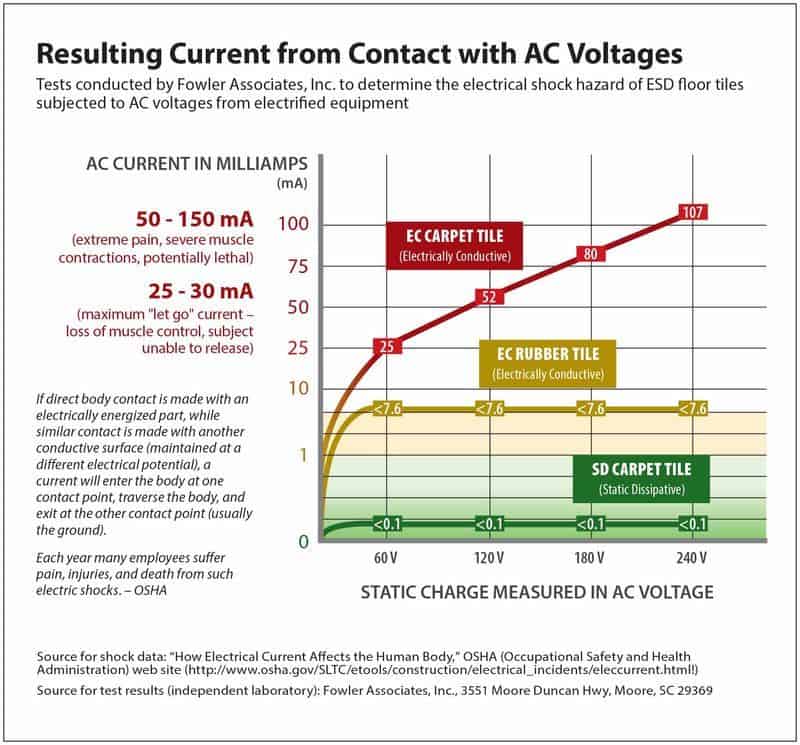
As you see in the chart, both static-dissipative carpet and EC (electrically conductive) rubber restrict the flow of electricity sufficiently to prevent the floor from becoming part of a dangerous circuit. An overly conductive carpet, on the other hand, could expose the same person in the same scenario to a significant shock hazard.
Note: due to its material composition, conductive rubber restricts and controls the flow of electricity more predictably than composite floors like conductive carpet tile.
Static-dissipative Floors
Static dissipative floors have more electrical resistance than conductive floors – i.e., they slow the flow of electricity. Electricity flows at a more controlled rate across a static-dissipative than a conductive floor.
Like a funnel with a very narrow hose, highly dissipative floors — with resistance measurement of 1.0 x 10E9 — provide too much resistance. If water were to flow continuously into a funnel with a very narrow hose, the cone would empty too slowly to keep up with demand and the funnel would overflow. When we walk on a floor with a very high electrical resistance, static charges move through the floor too slowly and static builds on our body.
Walking Body Voltage and Static Discharge
When we walk across a floor, the contact and separation between the floor and soles of our shoes generates static. As we continue to walk, static accumulates on our body. This static charge is called walking body voltage.
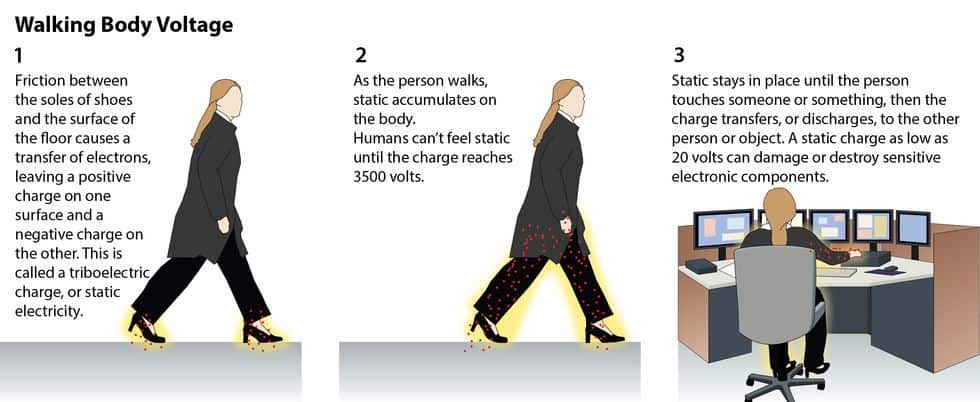

Like water in an overflowing funnel, when a person is carrying excess static electricity, the charge has to go somewhere.
If the electrical resistance of the floor is too high – > 10E9 ohms – , static cannot flow to ground quickly enough to prevent static charges from accumulating on people. These charges stay in place, on the body, and jump to the first person or object people touch. This transfer of static electricity is called electrostatic discharge, or ESD.
A minute static discharge (ESD event) – a discharge so small that humans can’t even perceive it – can damage or destroy static-sensitive electronic equipment and components.
The Sweet Spot
Is there an ideal range for conductivity or static dissipation?
We’re glad you asked. Yes. We call it “the sweet spot” – that is, between 1.0 x 10E5 and 1.0 x 10E8.
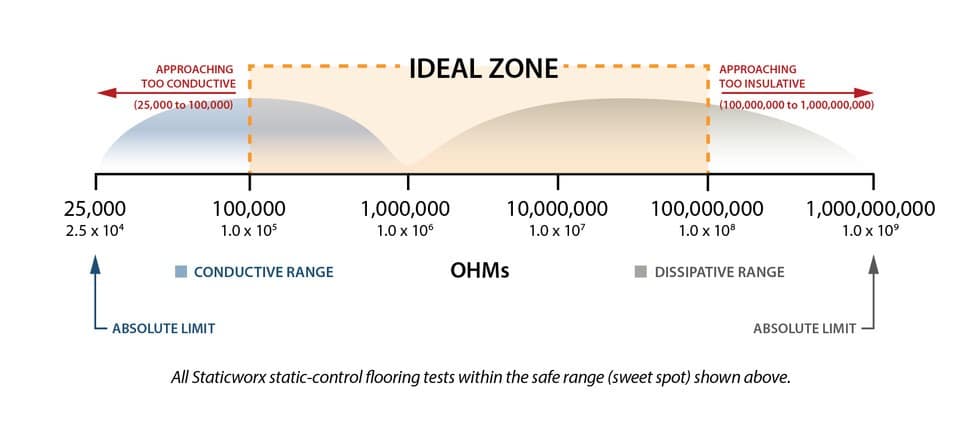

As noted above, electrical resistance below 10E5 allows electricity to flow too quickly, posing a potential safety risk. That’s why grounding standards like Motorola R56, FAA 019f and ATIS 0600321- 2015—governing the telecom, flight control, emergency and critical call centers, 9-1-1 dispatch, data centers and other end-user spaces—require floors to have a resistance range of at least 10E6 and no higher than 10E9.
Grounding standards like Motorola R56, FAA 019f and ATIS 0600321- 2015—governing the telecom, flight control, emergency and critical call centers, 9-1-1 dispatch, data centers and other end-user spaces—require floors to have a resistance range of at least 10E6 and no higher than 10E9.
Standard ANSI/ESD S20.20, governing electronics manufacturing and handling facilities, allows resistance up to 10E9 ohms to ground. While, in some cases, a floor measuring 10E9 may provide adequate static control, ambient humidity and other environmental factors can affect the ESD properties of a floor. If a floor measuring at the upper end of the acceptable resistance range were to lose any conductivity at all, it could too easily become out of spec, ineffective or even insulative.
Resistance measurements between 10E5 and 10E8 fall within the acceptable range for any ESD application. This range offers adequate tolerance against external variables like changing humidity and surface contamination.
Questions? We’re here to help. Call today: 617-923-2000
Here’s a short cartoon video using a slightly different water analogy to demonstrate The Sweet Spot.


Further Resources
About StaticWorx, Inc
All StaticWorx posts are written by our technical team and based on industry standards and specifications, test data, independent lab reports and other verifiable data. We provide ESD training and offer CEU credits to architects. If you’re interested in an ESD training session or our architects’ ESD workshop, give us a call: 617-923-2000.
Get in Touch
The form below will help us better understand your needs and get you as quickly as possible to the right person. We look forward to helping you solve your static problem!
You can expect a response within 24 hours. For faster service, please give us a call: 617-923-2000
"*" indicates required fields
Visit our privacy policy to find out how we process data.
More Blog Posts
To maintain performance, ESD floors require specially formulated products. We offer tips on what to consider when choosing cleaning supplies.
Static-dissipative floors transport harmful static charges to ground. Dissipative is also a term for flooring with a specific, measurable electrical resistance.
StaticWorx recognized as one of the fastest growing private companies in the U.S. 2023 marks StaticWorx fourth appearance on Inc. 5000 list.
Conductive and dissipative flooring protect electronics by transporting charges to ground, conductive at a quicker rate, dissipative slower & more controlled.
We explain the 3 main ways to test an ESD floor: Electrical resistance; body voltage & ESD audits, with advantages and reasons for each.
Three critical factors—application, industry standards & footwear—help you choose the best ESD floor, while ensuring the safety & efficiency of your operations.
StaticWorx Founder and President Dave Long shares three of his recommended reads: Quit, How to Change, and The Goal.
There are leadership qualities StaticWorx strives to embody every day, with every product, throughout each project.
No matter how you slice and dice a project, an ESD floor is a major investment. This blog post examines five ways to keep undue costs down.
What’s the difference between static control and static resistant? Or anti-static flooring? Find out more in our blog post.
A major part of any ESD control program is getting proper flooring in place. How can one replace a floor without generating any debris? Learn more.
A well-designed, comprehensive, fully realized program is a must for manufacturers serious about ESD control. Learn why ESD programs fail.
ESD Floors should never be specified based on the descriptive terms conductive or static dissipative. Always base ESD specs on verifiable metrics. Find out why.
<a class="eael-grid-post-link" href="https://staticworx.com/case-studies/esd-flooring-failure-incorrect-testing/" title="Blog Post: Case Study: ESD Flooring Failure, Incorrect Testing: Always Qualify Your Floor Using ANSI/ESD Test Methods">Blog Post: Case Study: ESD Flooring Failure, Incorrect Testing: Always Qualify Your Floor Using ANSI/ESD Test Methods
To comply with relevant ESD standards, test electrical properties using methods outlined in ESD S20.20. For best results require testing by an independent lab.
<a class="eael-grid-post-link" href="https://staticworx.com/installing/esd-flooring-installation-bond-test-manufacturer-oversight-critical/" title="Blog Post: ESD Flooring Installation:
Bond Test and Manufacturer Oversight Are Critical to ESD Flooring Success">Blog Post: ESD Flooring Installation:
Bond Test and Manufacturer Oversight Are Critical to ESD Flooring Success
If the vapor barrier fails to adhere to the subfloor, tiles will lift. Bond test and manufacturer oversight are crucial to ESD floor installation success.
Qualifying an ESD floor helps ensure you get the floor you paid for. Find out why you should always qualify according to ESD S20.20
Qualification is the first step in selecting an ESD floor. Learn how to perform resistance tests to be sure the floor meets electrical & safety standards.
Will bare concrete control static? Learn why concrete floors are unreliable & what precautions to take if you must work on a bare concrete floor.
A look at how the StaticWorx cartoon, 'Conductive Flooring Does Not Mean Antistatic Flooring,' was conceived and created.
Learning Center Articles
- ESD Basics
- Installation & Maintenance
- Selecting & Specifying an ESD Floor
- Technical Information
- 7 Common Mistakes Selecting an ESD floor
- A Guide to ESD Flooring Selection
- Avoid Costly Failures: What You Need to Know When Specifying ESD Flooring
- Choosing ESD Flooring for:
- ESD Footwear: What Is It and When Is It Necessary?
- ESD Footwear for Electronics Manufacturing and Handling Applications
- Facility Managers’ Guide to Selecting ESD Flooring
- The Need for Due Diligence in Specifying Static-Free Flooring
- Standard of Care for Specifying Floors in Mission-Critical Spaces
- Understanding the Hidden Costs of ESD Flooring

StaticWorx high-performance static-control floors protect electronic components, explosives, and high-speed computers from damage caused by static electricity. ESD flooring is part of a system. Choices should always be based on objective, researched evidence. When you partner with us, we look at all possible items that may need to integrate with the floor, and, focusing on your goals and objectives, help you find the right floor for your application.




